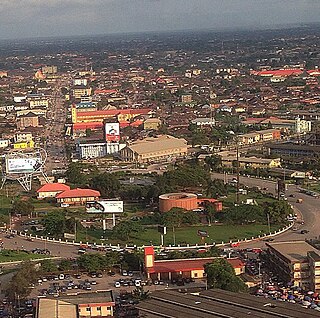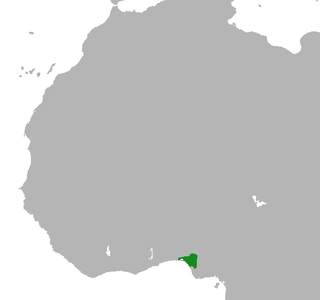
Benin City serves as the capital and largest metropolitan centre of Edo State, situated in southern Nigeria. Notably, it ranks as the fourth-most populous city in Nigeria, according to the 2006 national census, preceded only by Lagos, Kano, and Ibadan.
The Benin Expedition of 1897 was a punitive expedition by a British force of 1,200 men under Sir Harry Rawson. It came in response to the ambush and slaughter of a 250 strong party led by British Acting Consul General James Phillips of the Niger Coast Protectorate. Rawson's troops captured Benin City and the Kingdom of Benin was eventually absorbed into colonial Nigeria. The expedition freed about 100 Africans enslaved by the Oba.

The Oba of Benin is the traditional ruler and the custodian of the culture of the Edo people and all Edoid people. The then Kingdom of Benin has continued to be mostly populated by the Edo.

The Oyo Empire was a Yoruba empire in West Africa. It was located in present-day southern Benin and western Nigeria. The empire grew to become the largest Yoruba-speaking state through the organizational and administrative efforts of the Yoruba people, trade, as well as the military use of cavalry. The Oyo Empire was one of the most politically important states in Western Africa from the mid-17th to the late 18th century and held sway not only over most of the other kingdoms in Yorubaland, but also over nearby African states, notably the Fon Kingdom of Dahomey in the modern Republic of Benin on its west.

Ozolua, originally known as Prince Okpame, was the fifteenth Oba of the Kingdom of Benin who reigned from c. 1483 AD – c. 1504 AD. He greatly expanded the Kingdom through warfare and increased contact with the Portuguese Empire, and was later called Ozolua n'Ibaromi, meaning Ozolua the Conqueror in Edo. He was an important Oba in the history of the Kingdom of Benin and retains importance in the folklore and celebrations of the region.

Esan people, or Esans, are an Edoid-speaking ethnic group who share a common culture and the Esan language. The Esan are traditionally known to be agriculturalists, trado-medical practitioners, mercenary warriors and hunters. They cultivate palm trees, Irvingia gabonensis (erhonhiele), Cherry (Otien), bell pepper (akoh) coconut, betel nut, kola nut, black pear, avocado pear, yams, cocoyam, cassava, maize, rice, beans, groundnut, bananas, oranges, plantains, sugar cane, tomato, potato, okra, pineapple, paw paw, and various vegetables.

Ewuare, originally known as Prince Ogun, was the twelfth Oba of the Benin Empire from 1440 until 1473. Ewuare became king in a violent coup against his brother Uwaifiokun which destroyed much of Benin City. After the war, Ewuare rebuilt much of the city of Benin, reformed political structures in the kingdom, greatly expanded the territory of the kingdom, and fostered the arts and festivals. He left a significant legacy in the Kingdom of Benin

Benin art is the art from the Kingdom of Benin or Edo Empire (1440–1897), a pre-colonial African state located in what is now known as the Southern region of Nigeria. Primarily made of cast bronze and carved ivory, Benin art was produced mainly for the court of the Oba of Benin – a divine ruler for whom the craftsmen produced a range of ceremonially significant objects. The full complexity of these works can be appreciated through the awareness and consideration of two complementary cultural perceptions of the art of Benin: the Western appreciation of them primarily as works of art, and their understanding in Benin as historical documents and as mnemonic devices to reconstruct history, or as ritual objects. This original significance is of great importance in Benin.
The Afemai people, also spelled Afenmai are a group of people living in the northern part of Edo State south geopolitical zone of Nigeria.
Igueben is a local government area of Edo State, Nigeria. Its headquarters are located in the town of Igueben, which has an area of 380 km2 (150 sq mi) and a population of 69,639 according to the 2006 census. The postal code is 310.

The Kingdom of Benin, also known as Great Benin or Benin Kingdom is a kingdom within what is now southern Nigeria. It has no historical relation to the modern republic of Benin, which was known as Dahomey from the 17th century until 1975. The Kingdom of Benin's capital was Edo, now known as Benin City in Edo State, Nigeria. The Benin Kingdom was "one of the oldest and most developed states in the coastal hinterland of West Africa". It grew out of the previous Edo Kingdom of Igodomigodo around the 11th century AD, and lasted until it was annexed by the British Empire in 1897.
Igodomigodo is the original name of the Benin Empire used by its own inhabitants.
The Kingdom of Ugu is a kingdom that exists in Nigeria, in what is now Edo State. The Edo State is also called Benin, though it is not to be confused with the country. The Kingdom of Ugu originated out of Igodomigodo in Nigeria.

Esanland, otherwise known as Esan Nation, is a cultural region located in Edo State, Nigeria. It is composed of five Local Government Areas in Edo State. Esanland lies west of the banks of the Niger River. It is bordered by Kogi State, Delta State, Edo South Senatorial District, and Edo North Senatorial District. Esanland covers about 2,800 square kilometers and is home to over half a million people. The Esan people and culture of Esanland are generally homogenous.
Emotan was a market woman who traded in foodstuffs around the Oba Market in the ancient Benin kingdom during the reign of Oba Uwaifiokun and Prince Ogun, who later took the name "Oba Ewuare the Great" after becoming the Oba of Benin. She is the pioneer of the first day care centre in Benin City; oral history said she assisted Oba Ewuare in reclaiming the throne as Oba of Benin after several years in exile.
Unuamen also spelt Unuame is an ancient village community by Ovia river in Ovia North-East Local Government Area of Edo State, Nigeria. Unuame is about 15 kilometres (9 mi) from Benin City and 20 kilometres (12 mi) from Benin Airport. Unuame is one of the ancestral homes of Oba Esigie's maternal grandfather and home town to some group of Binis. The people of Unuame have remained loyal to the monarch since the establishment of the ancient Kingdom of Benin. Being a part of the Kingdom of Benin, Unuame is at the heart of the tropical rainforest in the southern part of Nigeria, way to the west of the delta of the Niger River and inland from the coast.
Agba N'Ojieof Uromi, originally called Agba, was the ruler of the Esan people from 1483 AD until 1507 AD. Considered an important Onojie in the history of the Esan people, he was instrumental in maintaining the independence of Esanland from the old Benin Empire.
The Benin Moat, also known as the Benin Iya, or Walls of Benin, are a series of massive earthworks encircling Benin City in Nigeria's Edo State. These moats have deep historical roots, with evidence suggesting their existence before the establishment of the Oba monarchy. Construction began around 800 AD and continued until 1460 AD, involving large-scale manual labour and the repurposing of earth from the inner ditch to build the outer berm. Some traditional sources claim that these earthworks spanned approximately 16,000 kilometres (9,900 mi), enclosing about 6,500 square kilometres (2,500 sq mi) of land, but very little remains today.

Orhogbua was the seventeenth Oba of the Benin Kingdom who reigned around c. 1550 AD – c. 1578 AD. He was the son of Esigie and the grandson of Ozolua. Orhogbua was educated in a Portuguese colonial school and was baptised as a Catholic. He was able to communicate in Portuguese, both spoken and written. He established a military camp on Lagos Island, which served as a strategic location for empire expansion and trade control. He also introduced the use of native cooking salt in Benin.
Ohuan, originally known as Prince Odogbo, was the nineteenth Oba of Benin who ruled from circa 1606 AD to 1641 AD. He was the only son of Ehengbuda, and he succeeded his father after his death. He is known for his unusual birth story, his rebellion against his Iyase Ogina, and his expansion of the Benin Kingdom through warfare. He died without an heir, leading to a succession crisis and a decline of the kingdom.










